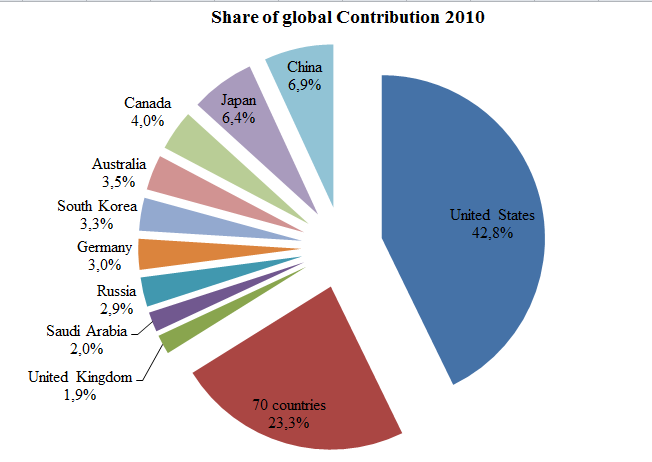Outsourcing of CO2 Emissions from the United States to China

2014
If the United States reduced the CO2 Emissions produced inside its borders and the dirty productions as a competitive consequence moved to China (or elsewhere), the positive impact on the climate would vanish. This obvious dilemma can only be solved if both countries sign a binding climate agreement with solid and fair CO2 Emission targets – which the two countries reject (read more on their COP positions ‘here’). The position of the United States is particularly perverted: 1) Reduction-targets of national CO2 Emissions must be voluntary and 2) Investments in climate actions must be profitable. The bizarre U.S. vision is to create a new global commercial market for voluntary climate investments, a commercial market with parallels to the United States, the homeland of the climate chaos.
In ClimatePositions 2010 the United States must contribute 43% and China 7% of a fictive Global Climate Fund (fictive because all appropriate initiatives have been undermined by the United States). The corresponding figures in 2005 were 47% and 3% – outsourcing of CO2 Emissions (moving abroad the dirty productions for domestic markets in the United States¹) keep the climate change top tuned. The remaining 50% of the global Climate Contribution (climate debt) is to be shared between 78 out of 145 countries. See the shares of Climate Contributions (climate debt) of the top ten contributors in the diagram and the ranking of all 145 countries in the menu “Contributions”.
The calculation method for the Climate Contributions are identical for all countries. The unused CO2 Emission amounts of the 65 Contribution Free countries are obvious targets for possible future outsourcing by CO2 burdened countries … how climate-wise is that? Well, how climate-wise was the increasing prosperity in the developed countries based on low-cost fossil energy for decades? ClimatePositions seeks to restrain CO2 Emission outsourcing to the Contribution Free countries in three ways: 1) Only a fraction of the unused Contribution Free CO2 Emissions is transferred from one twenty year period to the next, 2) Financing for green energy projects and related infrastructure is available when a global climate fund has been established, and 3) Rapid increase in CO2 Emissions from Contribution Free levels is predicted to reach the roof (India can only increase CO2 Emissions from 0.8 tons per capita in the 1990s to 2.1 tons in 2019 and still be Contribution Free).
China could have increased CO2 Emissions from 2.2 tons per capita in the 1990s to 2.5 tons in 2019 and still be Contribution Free, but the increase rate has been far too steep (6.5 tons per capita in 2011) and as a consequence the accumulated Climate Contribution (debt) is now $327 billion, second to the United States’ at $1,608 billion.
The COP Summits have proven one thing: The policies of United States do not demonstrate genuine care for future generations.
¹ ClimatePositions include a range of indicators in the calculation of the national Climate Contributions (read ‘here‘).
Source on CO2 Emissions: EIA, U.S. Energy Information Administration (links in the menu “Calculations”).
Comments are closed.